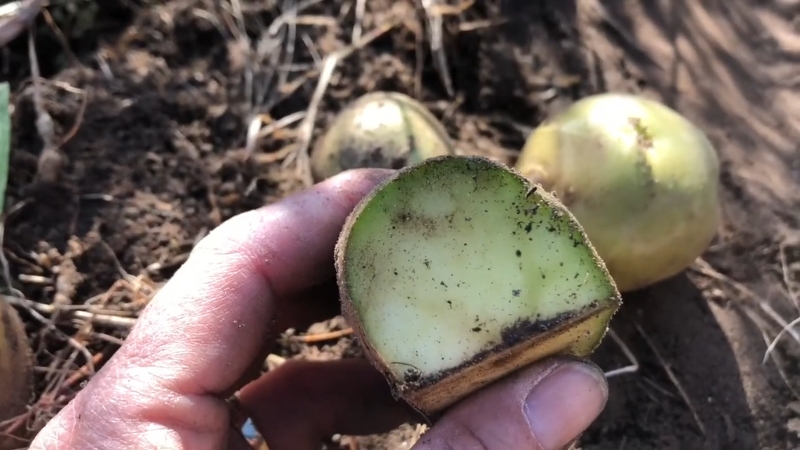Yes, green potatoes can be toxic if eaten in significant amounts. The green color signals the presence of solanine and chaconine, naturally occurring glycoalkaloids that the potato produces when exposed to light or damage.
These compounds are the plant’s defense against pests, but for humans, they can cause nausea, vomiting, headaches, and in extreme cases, more serious health issues.
The good news is that most people would need to eat a fairly large quantity of strongly green or sprouted potatoes to experience severe symptoms. Still, the safest approach is to avoid eating potatoes that have turned very green or bitter-tasting.
Why Potatoes Turn Green in the First Place

Potatoes are underground tubers; they’re designed by nature to grow in the dark. When they’re exposed to light, whether in a grocery store, warehouse, or your kitchen counter, two things happen simultaneously:
- Chlorophyll forms, which make the potato’s skin or flesh appear green. This pigment is not harmful by itself; it’s the same compound that makes leafy greens their color.
- Glycoalkaloids like solanine and chaconine increase. These are the plant’s natural pesticides and antifungal agents. They deter animals and insects from eating the tuber. Unfortunately, humans are also sensitive to them.
This is why food safety experts treat green skin as an indicator that solanine is present at higher-than-normal levels.
Solanine: The Potato’s Poison
Solanine has been known since ancient times as a potentially dangerous compound. It belongs to a group of naturally occurring chemicals called glycoalkaloids, found in all members of the nightshade family (which includes tomatoes, eggplants, and peppers).
- In low concentrations, solanine is harmless, and nearly all potatoes contain trace amounts.
- In elevated concentrations, it can disrupt cell membranes and interfere with nerve transmission in humans.
The symptoms range from mild stomach upset to more serious neurological issues if consumed in high doses.
Scientific Snapshot:
- The average potato has around 2–10 mg of solanine per 100 grams of flesh.
- Potatoes considered unsafe often exceed 20 mg per 100 grams.
- Toxic doses are estimated at 2–5 mg per kg of body weight.
That means an adult weighing 70 kg (154 lbs) would need to consume several large, very green potatoes in one sitting to reach dangerous levels. But because bitterness develops at these levels, most people instinctively spit them out before consuming too much.
Symptoms of Green Potato Poisoning
View this post on Instagram
When people do ingest excessive solanine, symptoms usually appear within 8 to 12 hours. They vary depending on dose, body weight, and sensitivity.
Common symptoms include:
- Bitter, burning taste in the mouth
- Nausea and vomiting
- Abdominal cramps and diarrhea
- Headache and dizziness
Severe symptoms (rare, high doses):
- Hallucinations
- Slowed breathing
- Fever
- Neurological effects like confusion or paralysis
In documented cases, symptoms typically last 24–48 hours. Hospitalization is rarely needed unless someone eats very large amounts or is particularly vulnerable (children, the elderly, or immunocompromised individuals).
Historical Cases of Solanine Poisoning
Green potato poisoning isn’t just a theory; it’s been recorded multiple times throughout history.
Documented Solanine Poisoning Cases
Year / Place
Event Description
Outcome
1899 – Germany
Schoolchildren ate boiled green potatoes.
Over 50 sick, several hospitalized.
1918 – UK (WWI food shortages)
Families consumed sprouted, stored potatoes.
Dozens reported severe illness.
1979 – UK
78 schoolboys ate green potatoes in a cafeteria.
17 hospitalized, all recovered.
1990s – Eastern Europe
Rural communities consumed poorly stored potatoes in winter.
Multiple outbreaks of food poisoning.
These outbreaks typically involved large groups eating stored, sprouted, or discolored potatoes when other food was scarce. Modern food supply chains have reduced the frequency of these incidents, but the risk persists if potatoes are mishandled.
Can Cooking Neutralize the Toxins?
A common misconception is that boiling or frying removes solanine. Unfortunately, this isn’t true. Solanine is heat-stable up to about 200°C (392°F).
- Boiling (100°C): Does not destroy solanine.
- Frying (160–180°C): Also insufficient.
- Baking (200°C+ for long periods): Can reduce levels slightly, but not reliably.
Eating undercooked potatoes can also pose risks, since the starches remain hard to digest, and any solanine present is not reduced by partial cooking.
So if a potato is green or bitter, cooking it won’t make it safe. The only effective prevention is cutting away green parts generously or discarding the potato altogether if it’s extensively affected.
Storage and Prevention: Keeping Potatoes Safe
The safest strategy is prevention: keeping potatoes from turning green in the first place. Solanine buildup is triggered by light, warmth, and time.
Best Practices for Storing Potatoes
- Keep them in a cool, dark, dry place (ideally 45–55°F / 7–13°C).
- Store in paper or burlap bags, never plastic (plastic traps moisture and light).
- Don’t refrigerate (cold temperatures convert starch to sugar, affecting taste).
- Don’t wash before storing (moisture accelerates sprouting).
- Rotate stock: Use older potatoes first.
When Should You Throw Them Out?
It’s not always black and white, but a few guidelines help:
- Small patches of green: Safe if you cut away thickly (at least ¼ inch).
- Large green areas covering the skin: Best to discard.
- Strong bitter taste even after peeling: Throw it away.
- Long sprouts + wrinkled skin: Indicates age and higher toxin levels; unsafe.
Quick Safety Table
Condition
Safe or Not?
Recommendation
Light green patch
Usually safe if peeled
Cut away deeply before cooking
Very green potato
Unsafe
Discard
Bitter taste
Unsafe
Stop eating immediately
Sprouted & shriveled
Unsafe
Discard
Are All Potatoes Equally Risky?
Interestingly, not all potato varieties are the same. Some have naturally higher glycoalkaloid levels than others. Breeders carefully monitor new varieties to keep levels safe for consumers, but certain heirloom or wild potatoes are naturally more toxic.
For everyday shoppers, common commercial varieties (Russet, Yukon Gold, Red) are safe as long as they’re stored correctly and not visibly green.
The Bottom Line

So, are green potatoes toxic? Yes – if consumed in quantity, they can make you sick, and in rare cases, dangerously so. But most people don’t eat enough of them to experience serious poisoning, because the bitterness is usually enough to stop you.
The green skin isn’t the poison itself, but it’s a warning flag that the potato contains elevated levels of solanine.
With proper storage and a little caution, the risk is easy to avoid. Potatoes remain a safe, affordable, and nutritious food – as long as you pay attention to color, taste, and condition before cooking.
Hi there, my name is Kelly Barlow and kellytoeat.com is my blog. Here, I write about various recipes I want to reccommend to readers.
I try to find the best possible recipes that can attract the attention of readers, and at the same time, I strive to write it in the most engaging manner possible.
When I was younger, I wanted to become a chef. Sadly, it wasn’t meant to be, but at the very least, I write about it.
